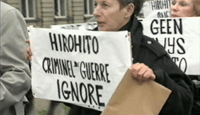Based on author, choreographer, activist, and filmmaker Lydia Chagoll’s autobiography A Childhood in the Japanese Camps and historical essay Hirohito: Emperor of Japan, The Little White Girl Had to Bow Her Head for Emperor Hirohito is a lucid and impassioned examination of the postwar geopolitics that have led to the cultural amnesia and historical whitewashing (enabled by western governments) of Hirohito’s role in the commission of atrocities during Japan’s expansionist campaign that culminated in the tragedy of the Pacific War. The daughter of an outspoken, anti-fascist journalist of Jewish ancestry, Chagoll fled her adopted home of Belgium with her family as a young girl in 1940 during the Nazi invasion, making their way south through the continent as refugees seeking asylum before being deported by South Africa – because of their Dutch-issued passports – to the island of Java in the Dutch East Indies (now Indonesia) in 1942. Detained and interrogated by authorities upon arrival to Batavia (now Jakarta) in an attempt to root out agitators seeking to undermine colonial authority, their belated freedom in the increasingly volatile region would prove to be short lived when Japan expanded their military campaign and began occupying the islands. Separated from their father and imprisoned in a series of progressively worsening conditions and inhumane treatment at concentration camps over the course of the next three years, Chagoll’s family would face even further humiliation when, at the end of the Pacific War, Indonesia declared its independence and Europeans were forced to remain in the camps for their own safety, still guarded by the same Japanese soldiers now tasked by General Douglas MacArthur to protect them as they await their delayed repatriation. Returning to Europe only to discover that their relatives had been killed at Auschwitz and Sobibor, the family’s harrowing ordeal in Java would be supplanted by their own guilt of survival and an immediate need to rebuild their interrupted lives, leading to a shared silence of history that would continue for decades until Frans Buyens convinced Chagoll to write about her experience as a means of exorcising her haunted past.
Structured as a talking head news panel with Chagoll, moderator Anne Blanpain, and actress and friend, Michèle Simonet reading passages from Chagoll’s memoir (the author, still reluctant to talk about her personal experience in the camps), the stark, brightly lit, minimalist sound stage reinforces the autobiographical and editorial dual nature of the film, serving as a platform for Chagoll’s recounted trauma that alludes to the austere circumstances of her captivity (where prisoners suffered from malnutrition and systematic abuse), and the idea that tragedy is inherently unfilmable (a theme that also finds kinship with Alain Resnais’s Night and Fog). Placing their discussions within the context of Chagoll’s public protests, first, during Emperor Hirohito’s state visit with King Baudouin in 1971, and subsequently, in the royal couple’s decision to attend his funeral in a sovereign capacity in 1989, Buyens and Chagoll frame Hirohito’s transformation from untried war criminal to venerated dignitary (presumably duped by a military clique into embracing expansionist policies) as the result of politically expedient revisionism, where the act of waging war (even a cold one) “has become so banal that it has given killers human faces.” In essence, Japan’s wartime amnesia is symptomatic of an absence of closure, a U.S.-orchestrated wholesale absolution designed to preserve the country’s hierarchical structure as a means of ensuring national stability and, consequently, a strategic foothold against an expanding communist threat. It is a negation of history that continues to shape the murky contours of contemporary Japanese society, most notably, in (then) Prime Minister Yasujiro Nakasone and his cabinet’s official visit to the controversial Yasukuni Shrine, a socially ingrained evasion of moral accountability and reckoning that once again comes full circle to its origins in Hirohito’s impunity from past transgressions that Chagoll challenges with the question: “Who is a war criminal: the one who kills, the one who gives the order to kill, the one in whose name the killing is done?”
© Acquarello 2008. All rights reserved.
